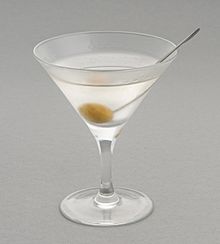Martini (cocktail) facts for kids
The martini is a very famous cocktail known around the world. It is traditionally made with gin and a special wine called vermouth. People often add an olive or a twist of lemon peel to it for decoration. A popular version, called the vodka martini, uses vodka instead of gin.
| IBA official cocktail | |
|---|---|

A martini with an olive garnish
|
|
| Type | Cocktail |
| Served | Straight up; without ice |
| Standard garnish | Olive or lemon twist |
| Standard drinkware | Cocktail glass |
| IBA specified ingredients |
|
| Preparation | Pour all ingredients into mixing glass with ice cubes. Stir well. Strain into chilled martini cocktail glass. |
| Timing | Before dinner |
| Notes | Squeeze oil from lemon peel onto the drink, or garnish with green olives if requested. |
Contents
How Martinis Are Made
By 1922, the martini recipe became quite standard. It usually involved mixing gin and dry vermouth. This mixture was stirred with ice and then poured into a chilled cocktail glass. People could choose to add an orange or other bitters if they liked. The most common decorations became a green olive or a twist of lemon peel.
What is a Dry Martini?
A dry martini means it has very little or no vermouth. If someone orders a martini "extra dry," it means they want even less vermouth. This style became very popular in the Roaring Twenties. Over time, people used less and less vermouth in their martinis. By the end of the 20th century, a "dry" martini usually had much more gin than vermouth.
Where the Martini Came From
The exact beginning of the martini is not fully clear. Some people think the name came from the Martini brand of vermouth. Another idea is that it developed from a drink called the Martinez. This drink was served in the 1860s at the Occidental Hotel in San Francisco. People would often visit this hotel before taking a ferry to the nearby town of Martinez, California. Some people from Martinez believe a bartender in their town created the drink.
Old bartending guides from the late 1800s show recipes similar to today's martini. For example, Harry Johnson's Bartenders' Manual (1888) had a "Martini Cocktail" recipe. It used equal parts of Old Tom gin and vermouth.
In 1907, a bartender named William Boothby wrote a guide called The World's Drinks And How To Mix Them. He included a recipe for a "Dry Martini Cocktail" that was very much like the modern version. Some stories also link the first dry martini to a bartender at the Knickerbocker Hotel in New York City around 1911 or 1912.
During Prohibition in the United States (1920–1933), making gin illegally was easier. This helped the martini become a very popular drink. After Prohibition ended, good quality gin became available again. The drink then became even "drier," meaning less vermouth was used. In the 1970s and 1980s, martinis seemed old-fashioned. But by the mid-1990s, they became popular again, and many new versions appeared.
Different Kinds of Martinis
The classic martini has many different versions.
A perfect martini uses equal amounts of both sweet and dry vermouth.
A wet martini has more vermouth than usual. A 50-50 martini uses equal amounts of gin and vermouth. An upside-down or reverse martini has more vermouth than gin.
A dirty martini includes a splash of olive juice. It is usually decorated with an olive.
Sometimes, a martini is served "on the rocks." This means the ingredients are poured over ice cubes in a glass.
A Gibson is a dry martini that uses cocktail onions instead of olives for garnish.
The Vodka Martini
A vodka martini is a type of martini made with vodka instead of gin. It is mixed with dry vermouth and ice. The ingredients are chilled and then poured into a cold cocktail glass. It can be decorated with an olive, a lemon "twist," or cocktail onions. If it has an onion, it's called a vodka Gibson.
Other Drinks Called "Martini"
Sometimes, the word "martini" is used for other drinks that are mostly strong liquor. Examples include the Manhattan or Cosmopolitan. These drinks are often served in a martini glass, but they are not true martinis.
Many newer drinks also use "martini" or "-tini" in their names. Examples are appletini or chocolate martini. These drinks usually contain vodka and are served in a cocktail glass. However, they have very little in common with the original martini.
Another popular type is the espresso martini. This is often served as a dessert. It usually involves mixing espresso coffee with vodka, coffee liqueur, and sugar syrup. It is served in a chilled martini glass.
Martinis in Movies and TV
- The famous spy James Bond is known for ordering a "vodka martini, shaken, not stirred."
- This phrase first appeared in a Bond novel in 1956.
- In the movie Goldfinger (1964), James Bond himself first said the full phrase.
- In the TV show I Dream of Jeannie, Jeannie magically makes vodka martinis appear for Captain Nelson.
- In the TV show M*A*S*H, the main character, Benjamin "Hawkeye" Pierce, often makes martinis in his tent.
See Also
 In Spanish: Martini (cóctel) para niños
In Spanish: Martini (cóctel) para niños
- Bronx
- Dryness
- Gibson
- List of cocktails
- Vesper

